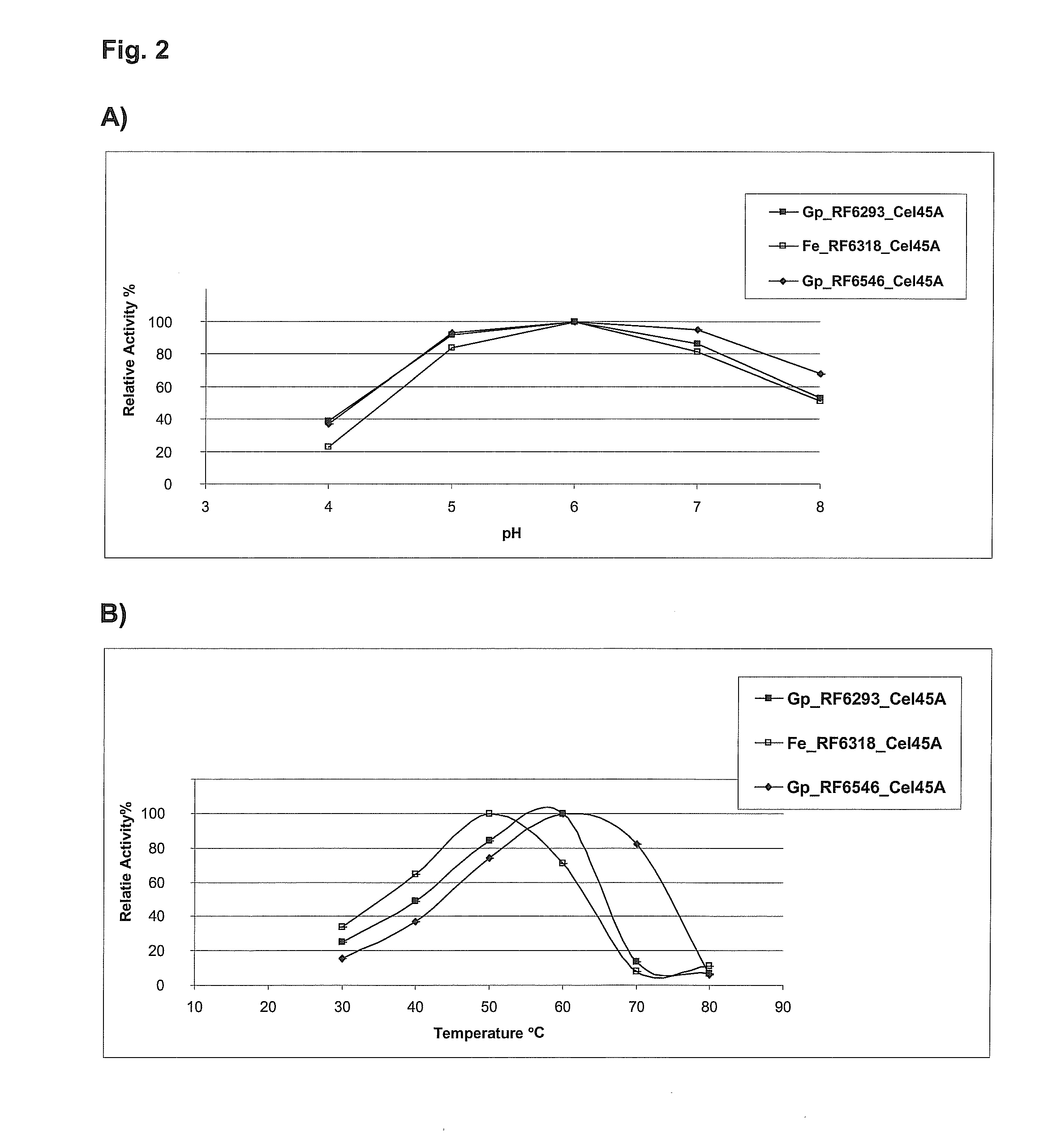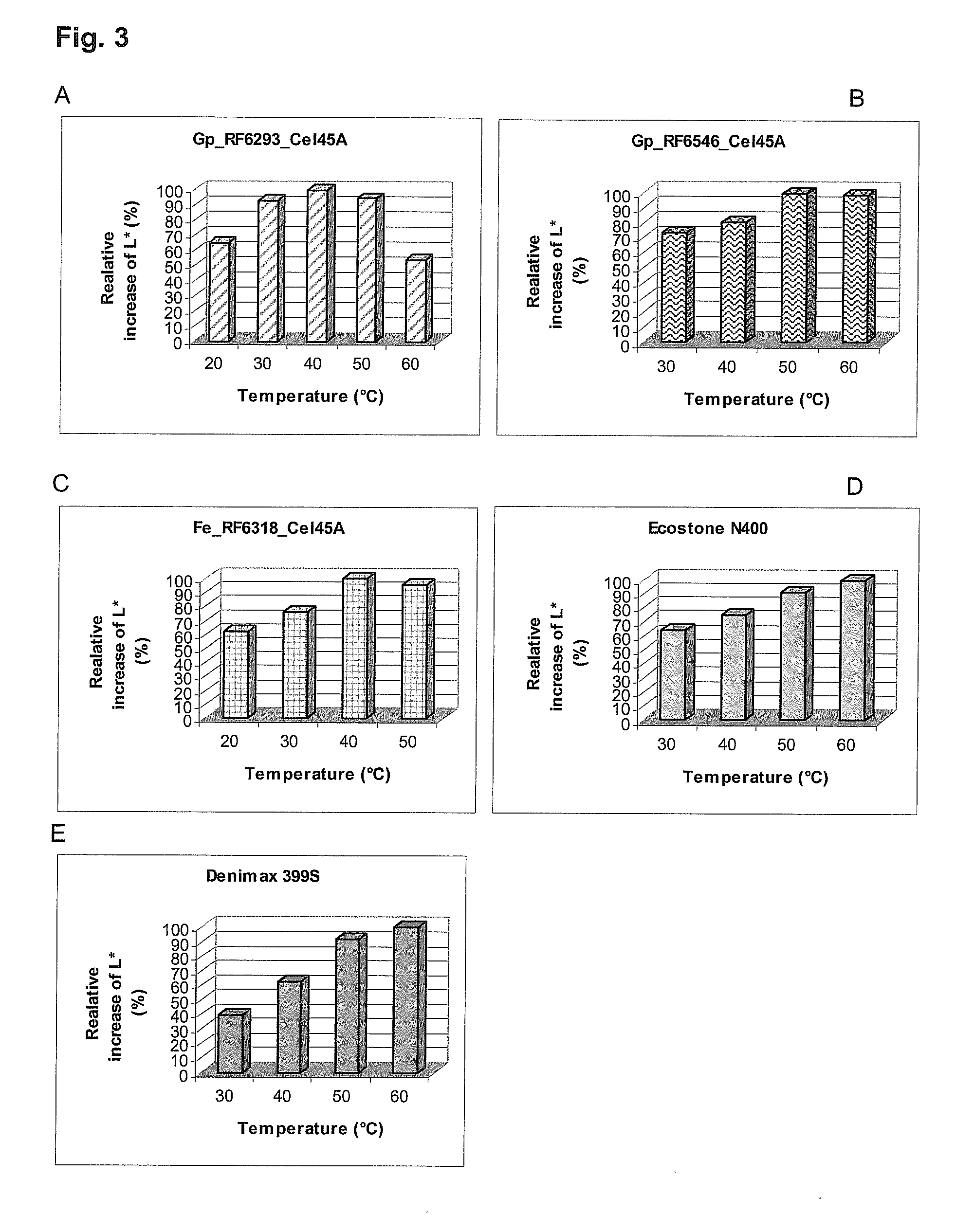Fungal Endoglucanases, Their Production and Use
- Summary
- Abstract
- Description
- Claims
- Application Information
AI Technical Summary
Benefits of technology
Problems solved by technology
Method used
Image
Examples
example 1
Screening for Strains Expressing Low-Temperature Cellulolytic Activity
[0081]About 180 fungal strains in the Roal Oy culture collection were tested for their ability to produce low-temperature cellulolytic activity. The fungal strains were cultivated in 100 ml volume on a rotary shaker (200 rpm) at temperature of 20° C. for 3-7 d. Several production media were tested containing Solka Floc cellulose as a carbon source. After the cultivation the cells and other solids were collected by centrifugation and the supernatant was recovered. If not used immediately, the preparation was stored in aliquots at −20° C.
[0082]For the estimation of the enzyme activity at lower temperatures, assays were performed of the shake flask cultivation preparation at 30° C. and 50° C. for 1 h. All shake flask supernatants were assayed for the following activities:
[0083]The endoglucanase (CMCase) activity:
[0084]This was assayed with 3% (w / v) carboxymethylcellulose (CMC) as the substrate in 50 mM citrate buffer...
example 2
Cloning of the Endoglucanase Genes from Geomyces pannorum RF6293, RF6546, RF6608, and Fusarium cf. equiseti RF6318
[0089]Standard molecular biology methods were used in the isolation and enzyme treatments of DNA (plasmids, DNA fragments), in E. coli transformations, etc. The basic methods used are described in the standard molecular biology handbooks, e.g. Sambrook et al., (1989) and Sambrook and Russell (2001).
[0090]Lambda DASH®II / BamHIH vector (Stratagene, USA) was used in the construction of the genomic libraries for Geomyces pannorum RF6293, RF6546, RF6608, and Fusarium cf. equiseti RF6318 according to the instructions from the supplier. The chromosomal DNAs, isolated by the method of Raeder and Broda (1985), were partially digested with Sau3A. The digested DNAs were size-fractionated and the fragments of the chosen size (5-20 kb) were ligated to the BamHI digested lambda vector arms. The ligation mixtures were packaged using Gigapack III Gold packaging extracts according to the ...
example 3
Production of Recombinant Cel45 Proteins in Trichoderma reesei
[0099]Expression plasmids were constructed for overexpression of recombinant Cel45 proteins from Geomyces pannorum RF6293 and RF6546, and Fusarium cf. equiseti RF6318 in Trichoderma reesei. The expression plasmids constructed are listed in Table 10. The recombinant cel45 genes, including their own signal sequences, were exactly fused to the T reesei cbh1 / cel7A promoter (p cbh1). The transcription termination was ensured by the T. reesei cbh1 / cel7A terminator (t cbh1) and the A. nidulans amdS marker gene was used for selection of the transformants as described in Paloheimo et al. (2003). The linear expression cassettes (FIG. 1) were isolated from the vector backbones after NotI digestion and were transformed into T. reesei A47 and / or A51 protoplasts (both strains has the genes encoding the four major cellulases CBHI / Cel7A, CBHII / Cel6A, EGI / Cel7B and EGII / Cel5A deleted). The transformations were performed as in Penttilä et...
PUM
| Property | Measurement | Unit |
|---|---|---|
| Temperature | aaaaa | aaaaa |
| Temperature | aaaaa | aaaaa |
| Fraction | aaaaa | aaaaa |
Abstract
Description
Claims
Application Information
 Login to View More
Login to View More - R&D
- Intellectual Property
- Life Sciences
- Materials
- Tech Scout
- Unparalleled Data Quality
- Higher Quality Content
- 60% Fewer Hallucinations
Browse by: Latest US Patents, China's latest patents, Technical Efficacy Thesaurus, Application Domain, Technology Topic, Popular Technical Reports.
© 2025 PatSnap. All rights reserved.Legal|Privacy policy|Modern Slavery Act Transparency Statement|Sitemap|About US| Contact US: help@patsnap.com



